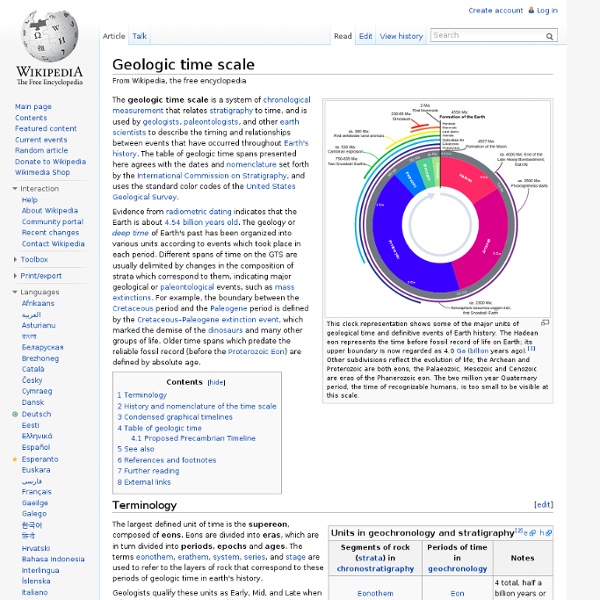Geology Entrance
You might wish to start in the Cenozoic Era (65 million years ago to the present) and work back through time, or start with Hadean time (4.5 to 3.8 billion years ago) and journey forward to the present day. No matter "when" you start, don't forget to stop along the way to learn about the stratigraphy, ancient life, fossil localities, and tectonics of the various time periods. Here are three links that can help to speed your journey: 1) Get helpful hints on navigating the Geology Wing. 2) Read about the history of the geologic time scale, and find out more about how it is organized. 3) Jump to a specific time period using the UCMP Geological Time Machine. Last but not least, don't forget to visit our exhibit on Plate tectonics, an important geological concept in any time period!
Geological history of Earth
Geologic time represented in a diagram called a geological clock, showing the relative lengths of the eons of Earth's history and noting major events The geological history of Earth follows the major events in Earth's past based on the geologic time scale, a system of chronological measurement based on the study of the planet's rock layers (stratigraphy). Earth formed about 4.54 billion years ago by accretion from the solar nebula, a disk-shaped mass of dust and gas left over from the formation of the Sun, which also created the rest of the Solar System. As the surface continually reshaped itself over hundreds of millions of years, continents formed and broke apart. The present pattern of ice ages began about 40 million years ago, then intensified at the end of the Pliocene. Precambrian[edit] The Precambrian includes approximately 90% of geologic time. Hadean Eon[edit] Archean Eon[edit] By 3.5 billion years ago, the Earth's magnetic field was established. Proterozoic Eon[edit]
Prehistory
Prehistory (meaning "before history", or "before knowledge acquired by investigation", from the Latin word for "before," præ, and historia) is the span of time before recorded history or the invention of writing systems. Prehistory refers to the period of human existence before the availability of those written records with which recorded history begins.[1] More broadly, it can refer to all the time preceding human existence and the invention of writing. The notion of "prehistory" began to surface during the Enlightenment in the work of antiquarians who used the word 'primitive' to describe societies that existed before written records.[2] The first use of the word prehistory in English, however, occurred in the Foreign Quarterly Review in 1836.[3] The occurrence of written materials (and so the beginning of local "historic times") varies generally to cultures classified within either the late Bronze Age or within the Iron Age. Definition[edit] Stone Age[edit] Paleolithic[edit] uninhabited
Geologic time scale
Online exhibits Geologic time scale Take a journey back through the history of the Earth — jump to a specific time period using the time scale below and examine ancient life, climates, and geography. You might wish to start in the Cenozoic Era (65.5 million years ago to the present) and work back through time, or start with Hadean time (4.6 to 4 billion years ago)* and journey forward to the present day — it's your choice. Ways to begin your exploration: Use the links in the "time machine" below and explore a specific period that interests you.Read more about the geologic time scale, its origins and its time divisions.Find out more about plate tectonics, an important geological concept in any time period!
History of the Earth
The history of the Earth concerns the development of the planet Earth from its formation to the present day.[1][2] Nearly all branches of natural science have contributed to the understanding of the main events of the Earth's past. The age of Earth is approximately one-third of the age of the universe. An immense amount of biological and geological change has occurred in that time span. The first life forms appeared between 3.8 and 3.5 billion years ago. Geological change has been constantly occurring on our planet since the time of its formation and biological change since the first appearance of life. Geological time, condensed in a diagram displaying the relative lengths of the eons of Earth's history Geologic time scale[edit] The history of the Earth is organized chronologically in a table known as the geologic time scale, which is split into intervals based on stratigraphic analysis.[2][6] A full-time scale can be found at the main article. Millions of Years Formation of the Moon[edit]



